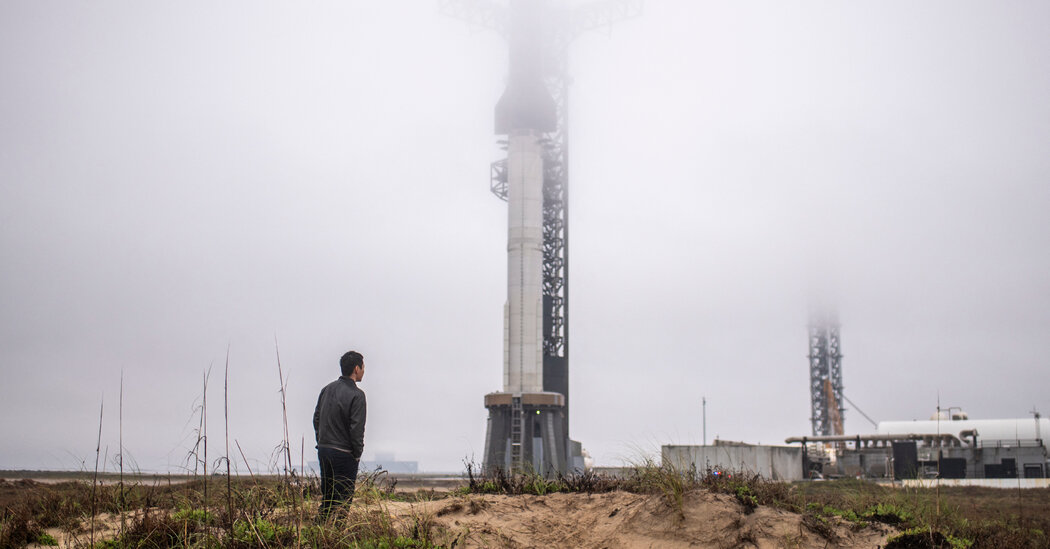Physical Address
304 North Cardinal St.
Dorchester Center, MA 02124
Physical Address
304 North Cardinal St.
Dorchester Center, MA 02124

SpaceX is ready for the seventh test flight of Starship – the giant rocket that company founder Elon Musk says will one day take people to Mars.
During the first six test flights, SpaceX has shown that it can build the largest rocket in space and more or less return the pieces to Earth. In the coming years, the company plans to turn “more or less” into “reliable” and prove other capabilities.
Here’s what to know about Thursday’s launch.
Thursday’s launch from Starbase, SpaceX’s launch site in south Texas, is scheduled for 5:37 p.m. Thursday. SpaceX will provide coverage on its website starting approximately 35 minutes before liftoff. The shipping window lasts until 6pm in the event of technical or other delays in inventory.
The Starship rocket system is the largest ever built – 403 meters tall, or almost 100 meters taller than the Statue of Liberty, including the pedestal.
And it has the most engines in the booster: The Super Heavy booster — the last part of the rocket — has SpaceX’s 33 Raptor engines poking out from underneath. When the Starship lifts off from the launchpad in South Texas, these engines will produce 16 million pounds of thrust at full throttle.
The upper part, also called Starship or ship for short, looks like a shiny rocket from a 1950s science fiction movie and is made of stainless steel with large fins. This is the upper stage that will go into orbit, and eventually may take people to the moon or even Mars.
President-elect Donald J. Trump attended the sixth test flight on November 19, visiting Mr. Musk in the launch control room. The upper Starship flew on a low-energy trajectory around the world, successfully re-entered the atmosphere and performed a downward maneuver, turning into a vertical position before gently sliding into the Indian Ocean about an hour later. one after departure.
Unexpectedly, it turned and exploded.
The booster also successfully re-entered the atmosphere. But the attempt to capture it using the mechanical arms of the launch tower – a feat that SpaceX achieved during the fifth test flight – was canceled after the sensor on the arm was damaged during the delivery. The booster was diverted to the Gulf of Mexico.
For the Starship on its seventh test flight, significant changes were made to the thrusters, heat shields and control system. The rockets are several feet wider than previous Starships – room for a large tank that holds 25 percent more space. The flaps on the top of the Starship are smaller and have been moved to the tip to reduce damage from re-entry temperatures.
While in space, the Starship will test a new system that looks like a PEZ candy dispenser. It will launch 10 dummy satellites the same size and shape as future spacecraft that will be deployed for SpaceX’s Starlink Internet service. The sophisticated satellites will follow the trajectory of the Starship and will be launched into space over the Indian Ocean.
In space, one of the engines will be restarted. The ability to fire the engines multiple times is needed to propel the future Starship into a stable orbit around Earth and also to provide the thrust back down to Earth when it’s time to return.
SpaceX will try another capture of the Super Heavy booster with a mechanical weapon on the launch tower.
That is still at least two years away. NASA plans to use a version of the Starship to take astronauts from lunar orbit to the surface of the moon during the Artemis III mission, which is scheduled for 2027.
Jared Isaacman, the billionaire founder of Shift4, a payment services company that has traveled to space twice on a SpaceX Falcon 9 rocket, will participate in the Starship’s first flight. But now that Mr. Trump has chosen him as the next NASA administrator, Mr. Isaacman is likely to stay on the ground, at least for now.